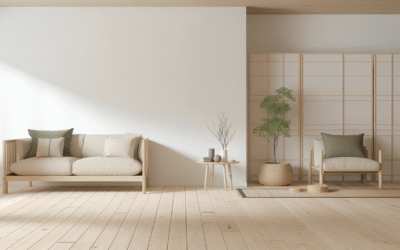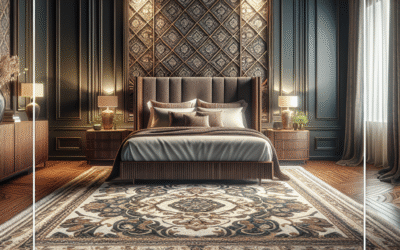
Have you ever stepped into a bathroom that felt more like a sanctuary than a simple washroom? If not, you’re in for a treat. Japandi design merges the calming aesthetics of Japanese interiors with the sleek functionality of Scandinavian styles. In this guide, you’ll discover an array of Japandi minimalist bathroom design ideas that transform your space into a tranquil retreat.
By the end of this article, you’ll gain valuable insights into creating a bathroom that not only looks stunning but also promotes relaxation and mindfulness. We will cover design principles, color palettes, furniture selections, and even practical tips to implement these ideas seamlessly.
Here’s what we’ll explore:
- The Core Principles of Japandi Design
- Color Palettes That Resonate
- Essential Furniture and Accessories
- Lighting Choices for Ambiance
- Case Studies and Real-Life Inspirations
The Core Principles of Japandi Design
Japandi design is more than just aesthetics; it’s rooted in principles that focus on both beauty and functionality. Here are the four core principles that define Japandi minimalist bathroom design:
1. Simplicity and Functionality
Every element in a Japandi bathroom serves a purpose. From the fixtures to the decor, functionality is paramount. This means opting for clean lines and minimal clutter.
2. Natural Materials
Wood, stone, and ceramics are favored in Japandi design. These materials not only enhance the natural beauty of your bathroom but also promote a sense of harmony and tranquility.
3. A Neutral Color Palette
Soft beiges, muted greens, and warm grays create a calming environment. Accent colors can be introduced through plants or textiles.
4. Integration with Nature
Luminous spaces that invite nature indoors are a hallmark of Japandi design. Consider large windows or greenery that can enhance your bathroom’s aesthetic.
Color Palettes That Resonate
Choosing the right color palette is essential for any Japandi bathroom. Here are some combinations to consider:
Neutrals with Earth Tones
- Soft beige walls paired with terracotta tiles.
- Light gray cabinetry with rich brown wooden accents.
Pale Blues and White
- Delicate blue walls combined with white porcelain fixtures.
- Bright whites paired with soft, natural textures.
Green Accents
Adding potted plants or green bathroom accessories can create a vibrant connection to nature.
Essential Furniture and Accessories
Furniture in a Japandi bathroom should be as functional as it is beautiful. Here are some must-have pieces:
Floating Vanities
Opting for a floating vanity can create a sense of space while providing essential storage. Look for wooden finishes to add warmth.
Minimalist Shelving
Open or floating shelving allows for easy access to essentials while keeping your space organized.
Natural Bath Mats
Seek bath mats made from organic materials such as cotton or bamboo for added comfort.
Lighting Choices for Ambiance
Lighting can dramatically impact the atmosphere of your bathroom. Here are some strategies to create the perfect ambiance:
Layered Lighting
Incorporate three layers of light: ambient, task, and accent. Use recessed lighting for overall illumination, pendant lights for tasks, and candles for accent lighting.
Natural Light
If possible, maximize natural light with strategically placed windows or skylights. They create a brighter, airier space.
Case Studies and Real-Life Inspirations
To truly understand Japandi bathroom design, let’s take a look at some real-world applications:
Case Study: Minimalist Retreat
A family in Seattle transformed their outdated bathroom into a Japandi haven using reclaimed wood, soft grey tile, and subtle plant accents. The result was a serene space that promotes relaxation.
Before and After: Urban Oasis
In a New York city apartment, a small bathroom made use of minimalist fixtures and a cohesive color palette. The use of natural light and organic materials made the space feel expansive.
Conclusion & Next Steps
By embracing the principles of Japandi design, you can create a minimalist bathroom that’s both functional and serene. Remember to focus on simplicity, use natural materials, and integrate greenery for added warmth. Start planning your transformation today, and consider visiting [Your Interior Design Blog](#) for more detailed guides and tips.
Content Disclaimer
The information provided in this article is for educational purposes only. Please consult professionals for specific advice regarding your design projects.
Frequently Asked Questions
<details>
<summary><strong>What is Japandi design?</strong></summary>
<p>Japandi design combines the minimalist aesthetics of Japanese design with the functional elements of Scandinavian style, emphasizing simplicity and natural materials.</p>
</details>
<details>
<summary><strong>How can I achieve a Japandi bathroom style?</strong></summary>
<p>Focus on using natural materials, a muted color palette, and functional furniture. Minimize clutter to create a serene environment.</p>
</details>
<details>
<summary><strong>What colors are best for a Japandi bathroom?</strong></summary>
<p>Soft neutrals, earthy tones, and pale blues work well in a Japandi bathroom. Consider accenting with greens for a vibrant touch.</p>
</details>
<details>
<summary><strong>What kind of lighting is suitable for a Japandi bathroom?</strong></summary>
<p>Layered lighting, including ambient, task, and accent lights, enhances the atmosphere. Natural light from windows or skylights is preferable.</p>
</details>
<details>
<summary><strong>Are there any specific furniture recommendations?</strong></summary>
<p>Floating vanities, minimalist shelving, and natural fiber bath mats are excellent choices to enhance your Japandi bathroom.</p>
</details>
Categories
- Accent Walls & Ceilings (61)
- Art Curation & Gallery (62)
- Bedding Style Trends (68)
- Bedroom Makeover (81)
- Bohemian & Eclectic Styles (58)
- DIY & Budget-Friendly Decor (64)
- Eco-Friendly Design (62)
- Furniture Care (71)
- Home Decor & Design Ideas (162)
- Home Wellness Spaces (59)
- Integrated Outdoor Living (67)
- Japandi Style (61)
- Kids and Nursery Decor (59)
- Living Room Decor (79)
- Mix & Match Techniques (73)
- Modern & Contemporary Design (66)
- Rug Sizing & Placement (73)
- Scandinavian Design Inspiration (20)
- Seasonal Home Decor (79)
- Small Space Solutions (73)
- Wall Art & Painting Tips (77)
Recent Comments
Archives
Product Gallery
-
Large Area Green Rugs for Bedroom Nordic Living Room Decoration Shaped Carpet Irregular Plush Lounge Rug Home Thick Washable Mat
Rated 5.00 out of 5$36.00 – $225.00Price range: $36.00 through $225.00 -
Nordic Style Rugs for Bedroom Morandi Living Room Decoration Carpet Large Area Geometry Lounge Rug Home Cloakroom Non-slip Mat
Rated 5.00 out of 5$26.00 – $387.00Price range: $26.00 through $387.00 -
Irregular Shapes Living Room Decoration Carpet Modern Style Rugs for Bedroom Home Thicken Plush Rug Fluffy Soft Lounge Floor Mat
Rated 4.83 out of 5$37.00 – $225.00Price range: $37.00 through $225.00














